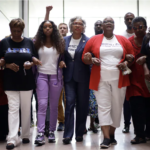| By Seth Sandronsky
New America Media Dec 06, 2009 Working in a hotel can be hazardous to your health, especially for women and ethnic minorities, according to a recent study of occupational injuries. The study is one of the first studies of injury incidence, rate and risk ratios by gender, employer, ethnicity, job group and race in the U.S. hotel industry. Researchers found that female hotel workers over-all were 1.5 times more likely to suffer injuries than males. Injuries to Hispanic female hotel workers were nearly twice that of white females. Meanwhile, Asian and Hispanic male employee injuries were 1.5 times greater than whites. Susan Buchanan, MD, of the University of Illinois Chicago School of Public Health, is the lead author of the study, presented at a recent meeting of the American Public Health Association in Philadelphia. “These alarming results raise many questions as to why injury rates are so high for women and Hispanic and Asian workers in the hotel sector,” she said. Buchanan and her co-researchers analyzed federal Occupational Safety and Health Administration data between 2003 and 2005 on nearly 3,000 worker injuries in five hotel job categories at 50 unionized properties of Hilton Worldwide, Hyatt Hotels, InterContinental Hotels Group, Marriott International and Starwood Hotels & Resorts Worldwide. Non-whites comprised 80 percent of the hotel employees in the study. The companies supplied the OSHA data to the labor union Unite Here, AFL-CIO, which represents 100,000 hotel workers at more than 900 properties in the United States and Canada. In turn, the union provided financial help. Joanna Shimekan, an independent consultant statistician associated with the University of Illinois School of Public Health, analyzed the data. At least one hotel company was skeptical of the study’s findings. “While we take seriously all valid research regarding workplace safety, we have not had the opportunity to thoroughly review the data and design of the Unite Here study,” said Amy Patti, a Hyatt spokeswoman. “However, it is clear to us that the union’s conclusions are not consistent with the workplace environment in our hotels.” John Wilhelm, the president of Unite Here, disagrees with Patti. “Hyatt, with the highest reported injury rate for housekeepers, needs to make changes immediately that will keep housekeepers safe and pain-free at work,” he said. Unite Here’s labor contracts with Hyatt in Chicago and San Francisco ended in August. Union workers in San Francisco protested the stalled talks with a three-day strike before returning to work in November. Every fifth employee in the study worked in housekeeping, and had the highest risk of being hurt, researchers found. Consider Celia Alvarez, a former housekeeper. She experienced a permanent injury working at a non-union Hyatt property in Long Beach. “Cleaning between 25 to 30 rooms a day demands working fast and this is how I hurt my body,” she said. There isn’t time to take care of our bodies. I have pain every day.” In each job category studied, the most common injury was to the upper extremity, according to the researchers. Injuries to the back and lower extremities of hotel workers were next in frequency. Employees at non-unionized hotels may be less likely to report their injuries to management, the study noted. Thus, unrepresented hotel employees who do not collectively bargain working conditions with employers could have higher injury rates than their union counterparts. The study did not conclusively pinpoint the links among company, gender, ethnicity, race and job factors and injury disparities. “The excess risk among Hispanic housekeepers compared to other housekeepers is more difficult to explain, and requires further study,” said Laura Punnett, ScD, of the University of Massachusetts Lowell, a co-author of the study. Future examination should focus on injury prevention methods for hotel workers, according to Niklas Krause, MD, a co-researcher on the study at the University of California, San Francisco. “It is time, especially for those companies with the worst rates,” he said, “to make a concerted effort to halt this disparate occurrence of work-related pain and suffering.” The union-backed study presented at the recent APHA meeting will appear in the peer-reviewed American Journal of Industrial Medicine in January. Seth Sandronsky lives and writes in Sacramento. Contact ssandronsky@yahoo.com.
|
||
|











